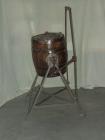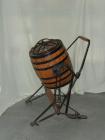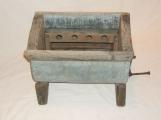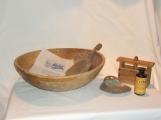14
Q:There have been many changes to technology in the kitchen over the last century, affecting everything from how you clean dishes to how to prepare meals. One of the more apparent changes was in how you acquired a simple ingredient like butter. Give a brief breakdown on how butter was made.
Q:To make butter you had to save enough cream - 2 or 3 gallons which depended on the size of your churn. You would churn the cream until the butter was formed. Then you would drain the butter milk. The butter had to be washed three or four times in very cold water then salt it. You could put the excess butter into a butter form that made a pound (500 grams). Then wrap it in butter paper then bring to the grocery store to trade or sell for groceries.
16
"In 1877 Dane Gustav de Laval invented the mechanical cream separator which great expedited butter production". p. 20 Hospitality December 1999.There were many butter churn inventions. This one operated by the handle causing the barrel to rotate. Cost was $10.95.
18
This butter churn could be operated by foot pedal allowing freed hands to be active on another project. Children often helped.20
This Quebec homemade churn is of wood and tin with wooden paddles used for smaller quantity of cream. It originally had a cover.22
When the process was completed the butter had to be worked, that is, washed and salted in the butter bowl. When the homemaker determined what quantity of butter needed for the family's use, the excess butter could be sold to neighbours/town people/general store. Butter bowl, paddle, form, butter colour, curd lifter, butter paper for wrapping butter into the (one pound) 500gr. size. Generally the wooden items were made of maple.The curd lifter cost 10 cents; maple butter bowl - $1.85; form -30 cents; butter ladle -20 cents. The bottle is butter coloring, to enhance the appearance of the finished product by adding a few drops while working the butter.



